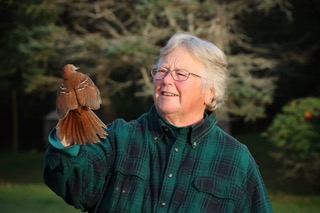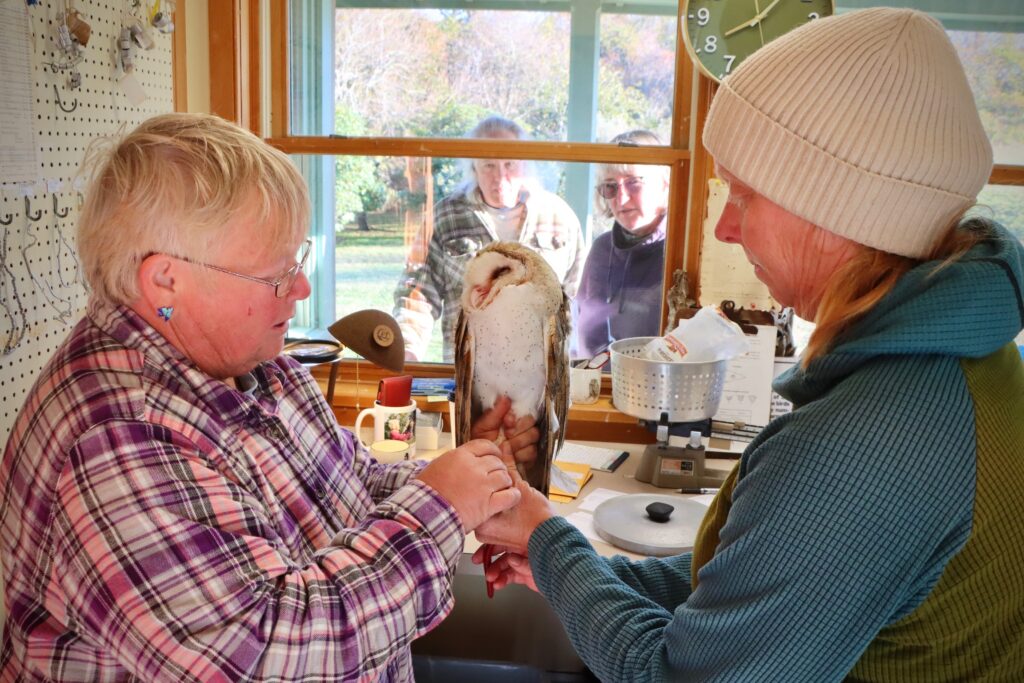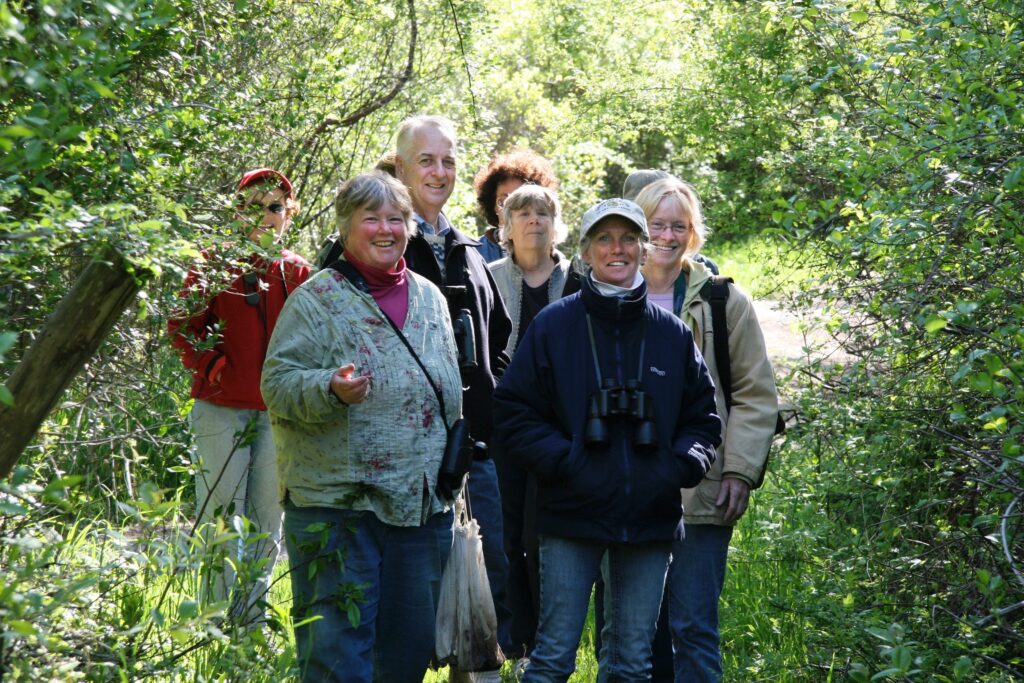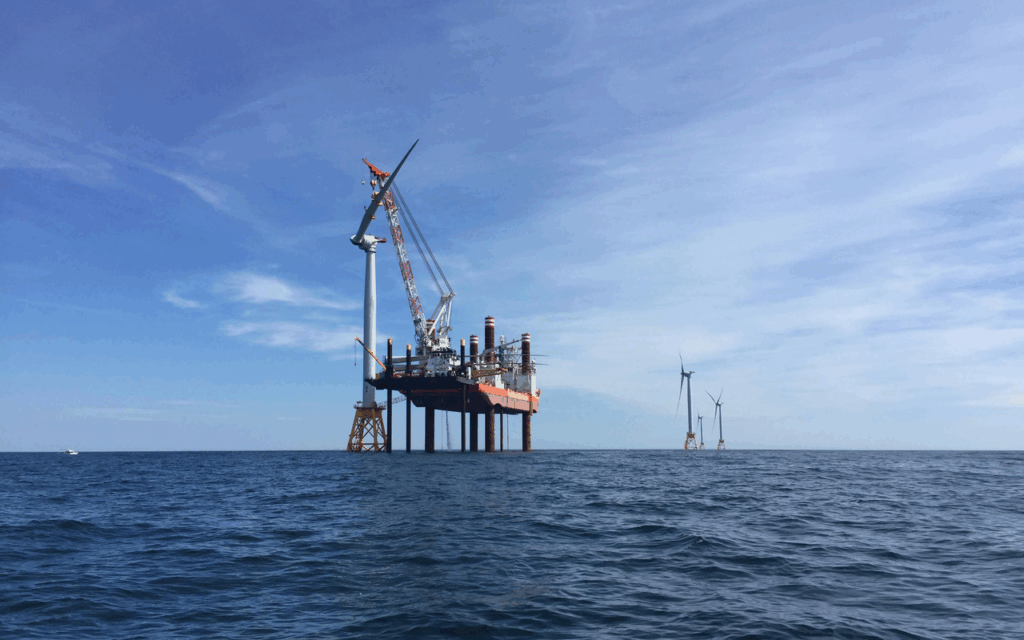
Those who know Kim Gaffett and her work agree: there are few who more fully embody the criteria of a distinguished naturalist than Kim Gaffett. On Block Island, where she grew up and has spent most of 50 years as a naturalist, Kim has been involved in virtually every aspect of environmental education, conservation, and research. The effects of her work are widespread, and her name is a byword for thoughtful, energetic, community-based natural history.
In the early 1980s, Kim began working with Elise Lapham at the bird banding station Lapham established on Clay Head. In the early 2000s, Kim came to run the banding operations, which continue to this day, one of the longest running banding records in the country, offering researchers a detailed and unique look at bird populations on the island and far beyond.

Kim’s bird conservation and research go far beyond the banding itself. Many groups and visitors have come to the Block Island Banding Station to learn from Kim. A highlight for the Block Island School second graders is visiting Kim at the banding station to see her work, to learn about the birds, and to release birds once they are banded. She has taught numerous other groups of students who visit the island and the banding station, giving them their first-ever close-up look at a bird, placing banded birds into the hands of children and adults who have never held a bird before. The impact this has on changing people’s connection to birds and their awareness of them in their everyday lives can never be explained in mere words.
Kim also continues the work of Block Island’s legendary naturalist and birder Elizabeth Dickens by leading a Community Bird Census on the day after Christmas – a ritual for many islanders and a delight to visitors.. Twice a month in the off season, Kim leads Crazy-As-A-Coot bird walks where she shares her knowledge and enthusiasm for the island’s winged visitors. During COVID she added a “Where-on-Earth” bird walk for folks anywhere on earth to send her their bird list for the day.
In addition to recognizing the importance of education, Kim understands that strong communities are also essential for lasting environmental conservation, especially in a literally insular setting. She has organized green screenings of environmental films for 20+ years, starting with solar-powered slide shows at the pavilion and including movie nights at the library in the summer and film and soup nights at the library in the winter. Kim is a regular contributor to the Block Island Times, writing the monthly “Ocean Views” column about the flora and fauna of the island. In 2022, her columns focused on the micro seasons on Block Island, enlightening residents and visitors about the many changes in the natural world that they might ordinarily miss.

Other creative ways Kim engages people in nature include organizing volunteers to count seals as part of Save the Bay’s work documenting the species on Narragansett Bay, organizing “Queerness in Nature” walks as part of Queer Block Island’s pride events, and planting projects for students and other volunteers establishing trees for Arbor Day, restoring dunes with beachgrass, and teaching about gardening with summer vegetable and flower beds. Kim uses her energy and island connections to facilitate all manner of work on Block Island by off-island researchers and educators that would be difficult or impossible without her: pollinator surveys, fish monitoring, moth, mushroom, and dragonfly inventories, invasive plant removal, other bird tracking projects, and natural history tours. Kim created an annual Mystery Walk on Block Island with a focus on a particular theme, such as landscapes, habitats, zoning, inland ponds, island history and more and is universally recognized as the first person to call when a sick or injured bird is found. She has returned many birds to the wild.

Kim served as the director of the Ocean View Foundation (OVF) from its inception in 2000 until its programs were transferred to The Nature Conservancy (TNC) in 2017. The Foundation’s goal was to educate islanders and visitors on the natural history and beauty of Block Island. She was instrumental in helping to save the site of the old Ocean View Hotel and turning it into a park and nature area. This included building the foundation’s open-air pavilion overlooking Old Harbor where she runs many of her programs and community events. The nature-themed artwork and other features at the site are created by local kids under Kim’s tutelage. Over the years she has created a full schedule of summer programs covering everything from bird banding and stargazing to identifying wildflowers and plants, art and nature walks, and many more. At her Earth Mother’s Day event, the coming of Spring is celebrated by the community.
In 2017, Kim went to work with the Nature Conservancy on Block Island where she occupies the Ocean View Foundation Perch as a naturalist and educator. The work she did at OVF moved with her to TNC and has grown to include more programs and events that help visitors understand the natural history of the island and the importance of supporting and maintaining its wild ecology. Kim has appeared in numerous publications and on radio and TV to discuss and promote environmental issues and nature on Block Island and elsewhere. In 2021, she was featured in an episode of the BirdNote podcast, “Threatened,” demonstrating banding, talking about the importance of collecting science data as a way of understanding the changes we are making to the ecosystem, and introducing students to her work.

During her second tenure as Block Island’s First Warden (the town’s mayor) from 2006-2014, Kim became an advocate for the Block Island Wind Farm, the nation’s first offshore wind generation project. Kim highlighted the damage climate change is doing not only to Block Island but to the whole world and urged the construction of the wind farm as a way to cut the island’s dependence on fossil fuels for electricity. The wind farm was built and stands as a testament to Kim’s promotion of public awareness of environmental issues. The five turbines at the wind farm now supply 100 percent of Block Island’s power needs as well as contributing green energy to the power grid on the mainland and helped create public acceptance of offshore wind energy that paved the way for larger projects nearby.
Rising seas created by climate change are a critical problem for low-lying islands like Block Island, and Kim is an active member of the Sea Level Rise Committee on the island, helping to plan for a future when the island may look drastically different than it does now. Kim has been an advocate for “living green” for many years and has lived totally off the grid since 1992, using solar cells to power her home. She has coordinated green renovations to several properties on the island owned by the Ocean View Foundation.
Being a naturalist, scientist, educator, in service to others is Kim’s life’s work. It is also her way of doing things to show up, roll up her sleeves and put in the work to make them happen. If not for Kim’s efforts, Block Island would surely be a much different place.
While most of her work has focused on the island, Kim has also had a reach beyond its shores. She served on the board of the Rhode Island Natural History Survey and as its president. She consulted with other naturalists and groups throughout New England, including the Island Institute in Maine, to help other island communities grow and adapt in changing times.
Kim Gaffett embodies the best qualities of a community leader and a scientist . . . a community scientist. She has been active in so many areas of environmental education and awareness, that it is close to impossible to list them all. It is equally difficult to overstate how important Kim’s work on Block Island has been in cataloging and researching the flora and fauna there, in making island residents and visitors aware of that rich natural heritage, and in promoting that heritage to the wider world. She is truly an ambassador for the beauty and importance of the natural world. She lives her work every day and inspires a sense of awe, wonder and responsibility in others.
Adapted by David Gregg from nomination letters by Curt Milton, Penny Lapham, Erica Anderson, and Scott Comings. Photos courtesy of Curt Milton.